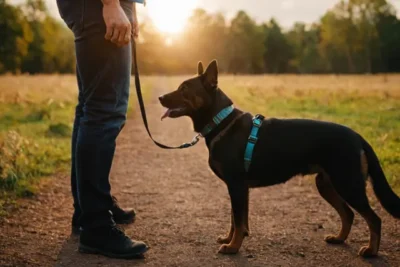



One of the most effective methods for teaching a dog to respond to a call is through positive reinforcement. This involves rewarding the dog for coming when called with treats, praise, or play. By associating the act of coming when called with something positive, the dog will be more motivated to respond to the call.
When using positive reinforcement, it's important to reward the dog immediately after they come when called. This helps to reinforce the behavior and make the connection between the action and the reward. Consistency is key in positive reinforcement training, so be sure to reward the dog every time they respond to the call.
Clicker training is another effective method for teaching a dog to respond to a call. This training technique involves using a clicker, a small handheld device that makes a distinct clicking sound when pressed. The clicker is used to mark the desired behavior, in this case, coming when called.
To use clicker training for recall, start by associating the sound of the clicker with a reward. Click the clicker and immediately give the dog a treat. Repeat this several times until the dog understands that the clicker sound means a reward is coming. Then, when you call the dog and they come to you, click the clicker and give them a treat. This helps to reinforce the behavior and make the connection between the clicker sound, the action, and the reward.
Consistency and repetition are crucial when teaching a dog to respond to a call. Dogs thrive on routine and repetition helps to reinforce the desired behavior. Use the same cue or command every time you call the dog, such as "come" or "here". This helps the dog to understand what is expected of them.
Consistency also applies to the way you reward the dog. Use the same rewards, whether it's treats, praise, or play, every time the dog responds to the call. This helps to create a predictable and positive association with coming when called.
Using a specific cue or command when calling your dog is important for effective training. Choose a word or phrase that is easy to remember and use it consistently. Avoid using the dog's name as the cue, as they may become desensitized to it over time.
When using the cue or command, be sure to say it in a clear and confident tone. This helps to grab the dog's attention and signal that you want them to come to you. Avoid using a harsh or angry tone, as this can create negative associations with the cue and make the dog less likely to respond.
When training a dog to respond to a call, it's important to start with short distances and gradually increase the distance over time. Begin by calling the dog from a few feet away and reward them when they come to you. As the dog becomes more comfortable and reliable in their response, gradually increase the distance between you and the dog.
This gradual progression helps to build the dog's confidence and ensures that they understand the behavior is expected regardless of the distance. It also helps to prevent the dog from becoming overwhelmed or distracted by longer distances right away.
Using high-value rewards can be a powerful motivator for a dog to respond to a call. High-value rewards are treats or rewards that the dog finds particularly enticing. These can include small pieces of cooked chicken, cheese, or other special treats that the dog doesn't receive on a regular basis.
By using high-value rewards, you increase the dog's motivation to come when called. They will associate the act of coming to you with receiving something they really enjoy. This can be especially helpful in situations where there are distractions or competing stimuli that may otherwise divert the dog's attention.
It's important to practice the recall command in different environments to ensure that the dog responds reliably in any situation. Start in a quiet and familiar environment, such as your backyard, and gradually introduce more distractions and challenges.
Practice in different locations, such as parks or other public spaces, to expose the dog to new sights, sounds, and smells. This helps to generalize the behavior and teach the dog that the recall command applies in any situation. Be patient and understanding if the dog is initially less responsive in new environments, as it may take time for them to adjust and feel comfortable.
Avoid using punishment or negative reinforcement when training a dog to respond to a call. Punishing the dog for not coming when called can create fear or anxiety, which can hinder their willingness to respond in the future.
Instead, focus on positive reinforcement and reward the dog for coming when called. This helps to create a positive association with the behavior and encourages the dog to repeat it. If the dog does not respond to the call, avoid scolding or punishing them. Instead, assess the situation and make adjustments to your training approach if necessary.
Patience and consistency are key when training a dog to respond to a call. Dogs learn at their own pace, so it's important to be patient and understanding throughout the training process. Avoid getting frustrated or giving up if the dog doesn't respond as quickly as you'd like.
Consistency is also crucial. Stick to a regular training schedule and be consistent in your approach. Use the same cues, rewards, and training techniques each time you work on the recall command. This helps to create a clear and predictable training environment for the dog.
If you're having difficulty teaching your dog to respond to a call, don't hesitate to seek professional help. A professional dog trainer or behaviorist can provide guidance and support tailored to your specific situation.
They can assess your dog's behavior, identify any underlying issues, and provide you with effective training techniques. They can also help you troubleshoot any challenges you may be facing and offer additional strategies to improve your dog's response to the recall command.
Remember, teaching a dog to respond to a call takes time, patience, and consistency. By using positive reinforcement, clicker training, and other effective methods, you can help your dog develop a reliable recall and ensure their safety and well-being.
Related posts